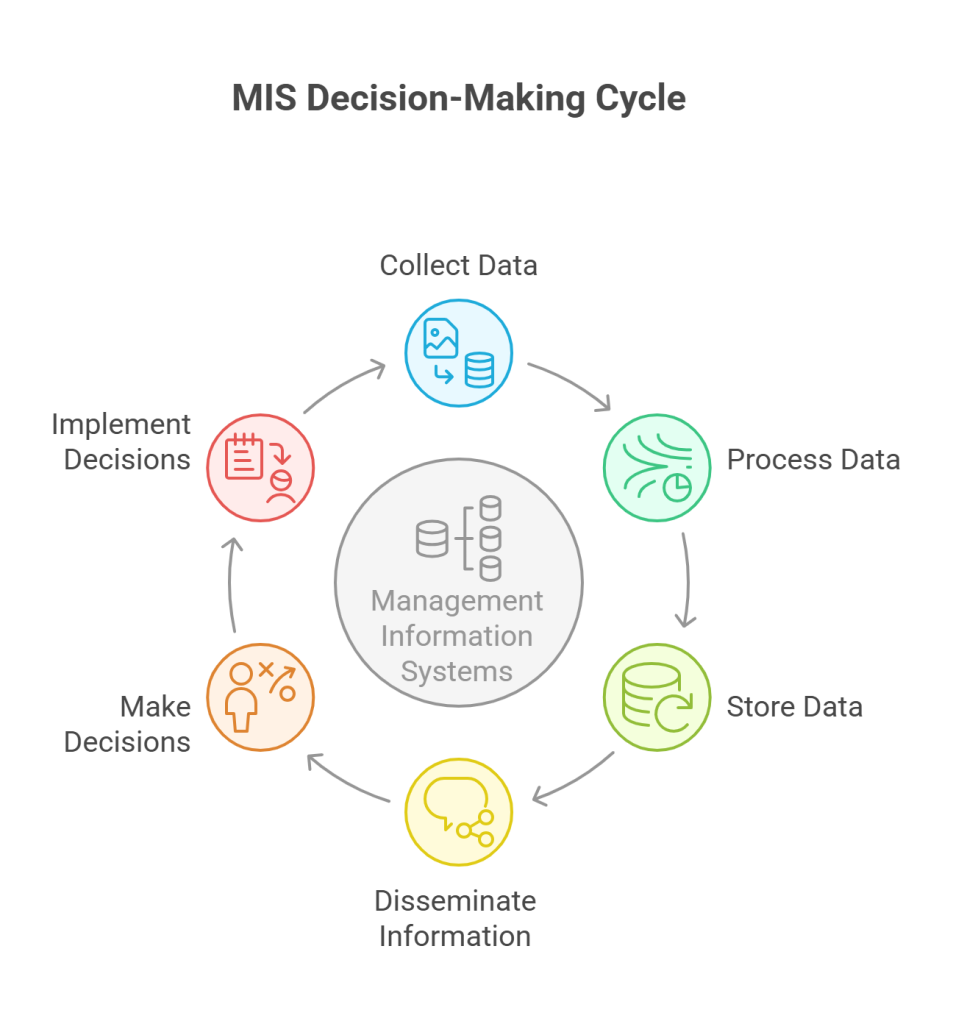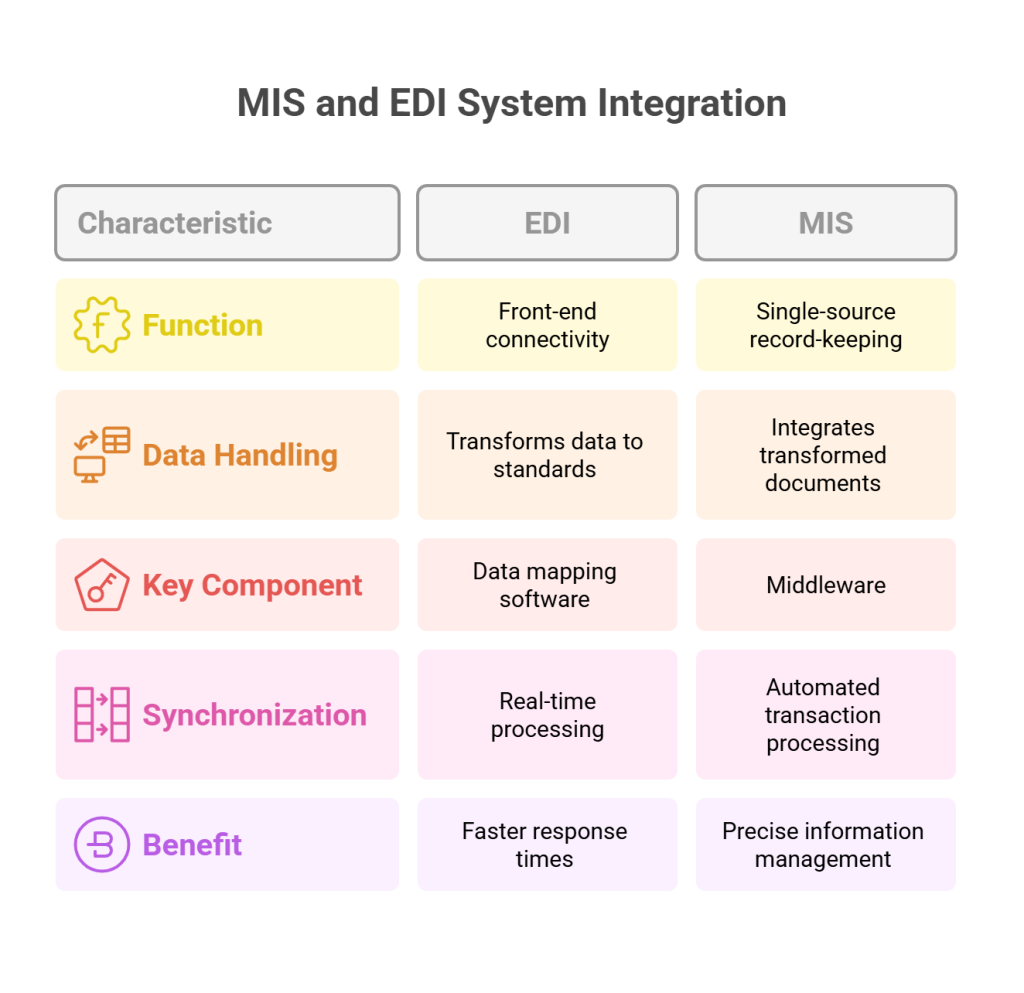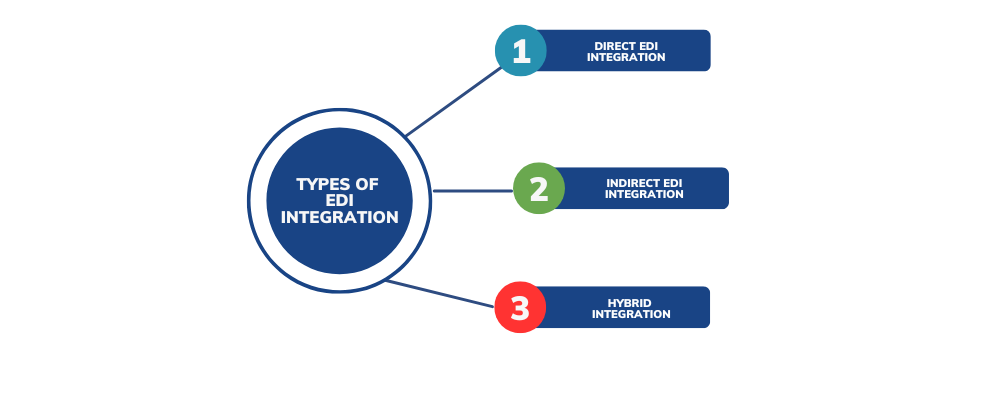Introduction
Did you know that Electronic Data Interchange (EDI) emerged in the 1980s as a revolutionary replacement for outdated communication methods like fax? Management Information System integration with EDI has significantly transformed how businesses exchange critical data.
In this blog, we’ll explore what a management information system is and its definition as a framework that facilitates organized data flow within organizations. We’ll also examine how an EDI system works to enable computer-to-computer exchange of business documents in standardized formats. Furthermore, the integration of EDI and ERP systems can lead to 100% centralization of data, providing real-time visibility into operations and enhancing decision-making capabilities. Businesses implementing these integrated systems experience faster response times, improved monitoring of pricing errors, and reduced operational costs.
We will guide you through the essential components of both systems, including EDI standards like ANSI X12 and EDIFACT that ensure consistency in data exchange across different regions and industries. Additionally, we’ll provide practical steps for implementing an effective MIS-EDI integration that can minimize errors associated with manual data entry while streamlining your business processes.
Understanding Management Information Systems (MIS)
Management Information Systems form the backbone of modern data management in organizations.
MIS is defined as a structured system that gathers, processes, stores, and disseminates information required for managing an organization effectively.
Essentially, it’s an integrated user-machine system designed to support operations, management, and decision-making functions through the intelligent use of technology and processes.

1. MIS Management Information System Definition and Scope
The scope of a Management Information System extends across all organizational levels. It encompasses five major components working together to achieve business objectives:
- People – Qualified professionals who use the system to record daily transactions
- Business Procedures – Agreed-upon best practices guiding users and components
- Data – Recorded day-to-day business transactions from various activities
- Hardware – Computers, printers, and networking devices providing computing power
- Software – Programs running on hardware, including both system and application software
MIS integrates these elements to collect, analyze, and present information so managers can make better decisions. Notably, this central storage system enables effective management of data across all organizational levels.
2. Types of MIS: TPS, DSS, and ESS
Different types of MIS serve specific organizational needs:
Transaction Processing Systems (TPS) record daily business transactions at the operational level. They answer routine questions like “How many products were sold today?” or “What is our current inventory?”. TPS provides highly detailed information for structured decisions by operational managers.
Decision Support Systems (DSS) assist middle and higher management with semi-structured and unstructured decision problems. These interactive systems help managers analyze data and test hypotheses by combining intellectual resources with computer capabilities.
Executive Information Systems (EIS) provide quick access to summarized reports from all company levels for top executives. Sometimes called Executive Support Systems (ESS), they support strategic planning through tools for forecasting, budgeting, and analyzing market trends.
3. Role of MIS in Business Decision-Making
The primary purpose of MIS in decision-making is to organize a company’s data from various sources and use it for generating reports that guide future decisions. Consequently, managers spend less time gathering information and more time implementing plans.
MIS contributes to decision-making by:
- Providing timely and accurate information to reduce uncertainty
- Automating routine tasks to reduce workload and increase productivity
- Supporting strategic planning through forecasting and trend analysis
- Converting raw data into meaningful insights for informed decisions
During strategic decision-making processes, MIS monitors any disturbances in the system and helps maintain control by suggesting particular courses of action. Despite technological advancements driving modern systems, the fundamental goal remains enabling effective management through quality information.
What is EDI and How It Works
Electronic Data Interchange represents a standardized method for exchanging business documents between computer systems without human intervention. Rather than relying on paper-based documents or emails with attachments, EDI enables digital systems to share and process documents automatically across organizational boundaries.
EDI System Definition and Core Functions
EDI functions as an automated exchange system that connects business partners’ IT systems, primarily using two transmission methods:
- Direct EDI connection – Links two business systems with secure protocols
- Value-Added Network (VAN) – Utilizes a third-party network that oversees data transmission
The core function of EDI involves translating business documents into standardized formats that receiving systems can process automatically. This translation happens through EDI software that maps data fields between internal systems and standardized formats. Secure protocols such as SOAP, SFTP, and HTTPS-based protocols (including AS2) enable the safe transmission of these documents between trading partners.
Common EDI Document Types: Invoices, POs, ASN
EDI systems typically process several standard document types that facilitate business transactions. The most frequently exchanged documents include:
EDI 850 (Purchase Order) initiates an order from the buyer to the supplier, containing item descriptions, quantities, pricing, and delivery dates. EDI 810 (Invoice) serves as a digital billing document requesting payment for delivered goods or services. EDI 856 (Advanced Shipping Notice) informs buyers about incoming shipments, providing carrier details, tracking numbers, and estimated delivery dates.
Other common documents include payment orders, inventory reports, and transportation status messages, all flowing directly between computer systems without manual intervention.
EDI Standards: ANSI X12, EDIFACT, TRADACOMS
EDI standards ensure consistency and compatibility across different systems. ANSI X12, developed by the Accredited Standards Committee X12, predominates in North America with over 300 transaction sets identified by three-digit codes.
EDIFACT (Electronic Data Interchange for Administration, Commerce, and Transport), maintained by the UN, sees widespread use internationally, particularly in Europe and Asia, with documents identified by six-letter references like ORDERS and INVOIC.
TRADACOMS, originally developed for the UK retail industry, consists of 26 messages primarily used in British domestic trade, especially in the retail and book industries.
Integrating MIS and EDI for Seamless Data Exchange
Merging Management Information Systems with EDI creates a powerful foundation for streamlined business operations. When these systems work together, they enable automatic document exchange and real-time data visibility across your organization.

Data Flow Between MIS and EDI systems
The integration connects EDI’s front-end capabilities with MIS/ERP back-end systems, creating seamless data pipelines. When properly integrated, EDI provides front-end connectivity between trading partners, whereas MIS/ERP enables single-source record-keeping and analysis. The combination improves efficiency and reduces errors by automating business document processing.
This integration works by implementing powerful mapping tools that adapt your data structures to any EDI standard. First, the system generates a canonical data structure, then adapts it to whatever EDI format is required at the destination. Subsequently, received standard documents are transformed into agreed-upon data structures for automatic integration into your MIS.
EDI ERP System Integration Architecture
Integration architecture typically includes these key components:
- Middleware connecting MIS/ERP and EDI systems to facilitate data transformation, routing, and workflows
- API Gateway serving as a managed entry point for all APIs
- Data mapping software that transfers fields like names and addresses into standardized documents
- Message routing software to deliver messages to the correct recipient addresses
Most integrated EDI solutions operate in SaaS mode, implemented on a private cloud architecture that establishes links with your MIS, CRM, and all management applications involved in electronic data exchange.
Real-Time Data Synchronization and Automation
Real-time synchronization allows businesses to process orders, invoices, and transactions instantly, accelerating order-to-cash and procure-to-pay cycles. Moreover, this automation enables EDI transactions to be processed automatically within the MIS system, ensuring your system data reflects accurate inventory levels, order status, and financial information.
The benefits include reduced costs, faster response times, more precise information management, and better decision-making. For example, manufacturing companies that integrate EDI with ERP can reduce manual order entry by 90%, eliminating fulfillment errors.
Switch to Commport EDI Solutions Today! A Leading EDI Provider Trusted by 6000+ Brands Worldwide. Offering Integrated EDI, Cloud EDI and Managed EDI Solutions.
Steps to Implement MIS-EDI Integration in Your Business
Implementing MIS-EDI integration requires methodical planning and execution to ensure successful deployment. A structured approach helps businesses navigate technical complexities while maximizing operational benefits.
Assessing Current MIS and EDI Capabilities
Before implementation, conduct a thorough analysis of existing business processes. This assessment identifies which areas can be optimized through EDI integration. First, evaluate your transaction volumes and document types processed regularly. Additionally, assess your current infrastructure, processes, technology stack, and partner matrix to understand what solution will deliver the most efficient results. According to studies, companies that properly assess their capabilities before implementation typically save 25% on overall costs.
Choosing the Right EDI Integration Type: Direct, Indirect, Hybrid

Three primary integration approaches exist, each with distinct advantages:
Direct EDI (point-to-point) establishes end-to-end connections with business partners using secure protocols like SFTP or AS2. This approach works well for handling high-volume transactions but requires managing individual connections.
Indirect EDI utilizes a Value-Added Network (VAN) or third-party broker to handle file conversions and transmissions. Although potentially more expensive due to transaction fees, this option simplifies partner onboarding and management.
Hybrid EDI combines both approaches, offering flexibility to accommodate various partner capabilities. This strategy often includes Web EDI portals that allow non-EDI-capable partners to generate and receive documents through web browsers.
Mapping Data Fields Between MIS and EDI
Mapping defines relationships between your internal data formats and standardized EDI formats. This critical step involves analyzing and aligning data fields from your MIS to corresponding fields in EDI documents. For instance, a “Customer ID” in your database must accurately map to the equivalent EDI field.
Effective mapping ensures:
- Minimized manual data entry errors
- Consistency across all data transmissions
- Reliable data exchanges with trading partners
Testing and Validating Document Exchange
Thorough EDI testing prevents issues before full deployment. Initially, test internal data flows from your MIS to the EDI portal. Afterwards, conduct pilot testing with selected partners to verify:
- Data accuracy and format compliance
- System integration functionality
- Error handling capabilities
- Transaction processing speed
During testing, maintain parallel paper-based processes until both parties confirm system reliability.
Monitoring and Maintaining the Integrated System
After implementation, continuous monitoring ensures optimal performance. Develop key performance indicators (KPIs) like reduced order processing times or improved invoice accuracy to track system effectiveness.
Switch to Commport EDI Solutions Today! A Leading EDI Provider Trusted by 6000+ Brands Worldwide. Offering Integrated, Cloud, and Managed EDI Solutions.
Hence, regularly audit your EDI processes to align with international compliance standards. Furthermore, implement AI-driven tools to monitor transactions and automate error handling, thereby reducing reliance on manual processes. Proper maintenance ensures your integrated system continues delivering efficiency gains while adapting to evolving business needs.
Conclusion
Companies implementing MIS-EDI integration experience faster transaction processing, significantly reduced manual entry errors, and real-time visibility across operations. Additionally, the integration architecture we discussed connects front-end EDI capabilities with back-end MIS functions, creating seamless data pipelines that automate critical business processes.
Though implementation requires methodical planning and execution, the resulting improvements in efficiency, accuracy, and decision-making capability make it worthwhile. As data volumes continue growing and business processes become increasingly digital, integrated MIS-EDI systems will undoubtedly remain essential tools for companies wanting to maintain competitive advantage through streamlined information exchange.
Commport EDI Solutions
Need Help? Download: Commport's EDI Buyers Guide
Unlock the full potential of your supply chain with our comprehensive EDI Buyer's Guide — your first step towards seamless, efficient, and error-free transactions
Frequently Asked Questions
EDI (Electronic Data Interchange) is a system that enables the automated exchange of business documents between computer systems. When integrated with Management Information Systems (MIS), it creates a powerful framework for streamlined data exchange, allowing businesses to process orders, invoices, and transactions in real-time.
EDI transmission primarily works through two methods: direct EDI connection, which links two business systems using secure protocols, and Value-Added Network (VAN), which utilizes a third-party network to oversee data transmission between trading partners.
Common EDI document types include purchase orders (EDI 850), invoices (EDI 810), and advance shipping notices (EDI 856). These standardized formats allow for efficient, automated processing of critical business information between trading partners.
What are the key benefits of integrating MIS and EDI systems?
To implement MIS-EDI integration, a business should first assess its current capabilities, choose the right integration type (direct, indirect, or hybrid), map data fields between systems, conduct thorough testing and validation of document exchange, and establish ongoing monitoring and maintenance processes to ensure optimal performance.





